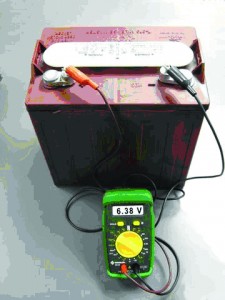QUESTION:
How do I test my batteries and help me understand them better?
WK – Carmel. Ind
ANSWER:
Since the heart and soul of an electric vehicle are the batteries, the first place to start with electric vehicle trouble shooting is always the batteries. Some things we need to know about trouble shooting batteries are as follows.
-
All lead acid cells are rated at 2.12 volts per cell with the exception of spiked or non lead acid batteries. Knowing that we have a base voltage to work from our next step is to determine how many cells you have. Simply count the number of water fill ports and multiply that times 2.12, and that is the battery pack voltage. So if we have 18 cells in the battery pack, the voltage is 38.16 volts and is termed a 36 volt system. Knowing the exact voltage is import-ant to test procedure. Say if we are at 36 volts, what will that mean to us? At 36 volts the cell voltage is 2 volts and at 2 volts this means the pack is discharged and will need charging before any further testing can be per-formed. This brings up the next test which is specific gravity. Specific gravity is just a measurement of the ratio of sulfuric acid to water. At 2 volts the specific gravity will be around 1.160 specific gravity. A battery is deemed fully charged at 1.280 specific gravity and discharged at 1.160. The 84 rule also supports the 1.160 reading as 2 volts minus .84 equals 1.160 gravity. Again some manufacturers use different gravity readings and we will use 1.280. So to say you have 36 volts, the batteries need charged as the correct full charge reading is 38.16 and in trouble shooting you need to understand that.
-
When testing a battery for voltage that is at rest (not being used), we call this an open circuit voltage (OCV) test. In a battery pack, testing of individual cell voltage is not feasible. We need to remember at this point that multiple cells make up a battery and most deep cycle lead acid batteries are either 6 volt or 8 volts. This is true for Golf Cars and in most cases any electric vehicle. In a battery pack you normally will have six 6 volt batteries (18 cells) or six 8 volt batteries (24 cells). There are also some that use eight 6 volt batteries (24 cells), as well as other combinations. An OCV test can tell us a lot in terms of battery condition. A good example of this is when you perform an OCV on each individual battery, a problem can be found rather quickly. Let’s say you have OCV readings of 6.36, 6.36, 4.8, 6.3, 6.1, and 6.21 on the individual batteries. What this tells us is battery number 3 is different and it is low and will need to be further tested. Also, battery number 5 is a tad low. What we are seeing are scattered voltages and that tells us there is a definite issue with the battery pack. First we will need to replace number 3 battery and recharge the pack and see if the scattered voltages improve. If improvement is not seen in number 5 battery, further testing will be required. To do this we will need to perform a discharge test.�
-
A discharge test for a 36 volt pack consists of a constant load of 75 amps applied for a period of 107 minutes. This is the normal discharge rating of a new T105 Trojan Battery. During the discharge process, the battery voltage can be monitored. This is called load volts and once again you are looking for a measurement that is different than the others. Say you read 5.88, 5.80, 3.2, 5.66, 5.70, and 5.67. Notice the number three battery reading is different. A reading of 3.2 is a defective battery that will not perform up to potential. Any system voltage reading below 31.5 volts at 75 amps before 60 minutes has passed is considered a system failure. It is my opinion after 35 years in the battery business that any single weak battery in a battery system will soon fail and a replacement should repair the problem, and thus prevent further damage to the rest of the pack. A general rule of thumb is if the entire pack is more than 2 years old, replace the entire set. Mixing a new battery with a set of old worn out batteries will destroy the new battery in a short period of time.
-
There are other simple load tests that the automotive industry uses that can tell a quick story. However, it can not sustain a load long enough for a total analysis. A cadmium test can be used, but I do not recommend this as it is a heavy metal and can be hazardous. One other test can be used to determine the health of a battery pack and this is the charging finish rate. The finish rate is voltage at the end of the charge cycle and is usually around 4 or 5 amps output from the battery charger. Again, we are using a 36 volt system for this test. What you will see is higher on charge voltages than you did on the OCV tests. New batteries tend to have a higher finish rate than older batteries. A good finish rate is usually around the 7.35 volts for each 6 volt battery. However, newer batteries can go as high as 8.25 volts. Let’s say you read 7.35, 7.40, 7.33, 7.34, 6.99, and 7.10. What this tells us is number 5 and 6 are different and will need further testing or replacement. With two batteries showing a low reading and taking into consideration the age of the pack, I would recommend you replace the set. Two batteries such as this in a newer pack would indicate issues with over discharging or excessive loads on the two batteries such as head lights and accessories. Again, never discharge batteries beyond the 80% level.
 VOLTMETER CONNECTION
VOLTMETER CONNECTION
In closing remember Batteries are a storage tank of electrical energy, and do not like to set dormant; “they need to be used”. Batteries like to be kept clean and have clean and tight connections.











